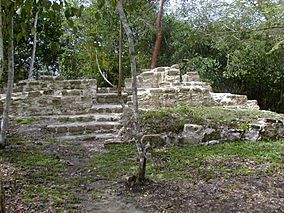El Pilar facts for kids
Quick facts for kids El Pilar |
|
|---|---|

Tzunu'un, a Maya house site surrounded by forest vegetation at El Pilar
|
|
| Location | Belize |
| Area | 20 km2 (7.7 sq mi) |
| Elevation | 200 m (660 ft) |
| Visitors | allowed |
El Pilar is an amazing ancient Maya city located right on the border between Belize and Guatemala. It's about 12 kilometres (7.5 mi) north of San Ignacio, Belize. You can reach it through San Ignacio and Bullet Tree Falls, which are near the Belize River.
The name "El Pilar" means "watering basin" in Spanish. This is because there are many streams and water sources nearby. This was quite special for a Maya city. El Pilar is the biggest Maya site in the Belize River area. It has more than 25 plazas (open squares) and hundreds of large buildings. The city covers about 120 acres (49 ha).
El Pilar is also part of a huge protected area. This area is called the El Pilar Archeological Reserve for Maya Flora and Fauna. Both Belize and Guatemala declared it a cultural monument in 1998.
Contents
Discovering El Pilar
Archaeologist Anabel Ford first mapped El Pilar in 1983. She was working on a project called the Belize River Archaeological Settlement Survey (BRASS). Her team studied how ancient Maya communities were set up.
They found that the size of communities was linked to how much farmland was available. El Pilar had one of the largest areas of farmland. It was about 10 kilometres (6.2 mi) north of the Belize River. This area was on the edge of a big hill that led to the major Maya city of Tikal.
History of the Ancient City
Since 1993, a big archaeological field survey and excavation project has been exploring El Pilar. Anabel Ford led this work. Her team made a detailed map using special survey tools. They focused on finding old pathways, stairs, and doorways.
When they mapped the monuments, they found a system of causeways. These ancient roads connected the eastern and western parts of the city. This meant one ancient Maya center was spread across two modern countries: Belize and Guatemala. Later, excavations dug into a main temple. They found that it had been built and rebuilt over 2000 years! Ford and her team are now using Lidar technology to map the area even more widely.
How El Pilar Grew
The city of El Pilar started to grow around 800 BC, during the Middle Preclassic period. The first small temples and plazas were found in the main eastern temple area, called Plaza Copal.
The city's public areas grew bigger over time. It reached its largest size before 1000 AD. At its peak, during the Late Classic period, it's thought that more than 180,000 people lived in El Pilar.
Exploring Maya Homes
Ford and her team have excavated many plazas, temples, and palaces. These were the main public buildings. Around these grand structures were the homes where the ancient Maya people lived.
One special home, called Tzunu’un, was found and mapped in 1984. It became a major focus for research. This elite Maya house was excavated, uncovered, and made stable. Today, it is the only ancient Maya house that the public can visit.
Working with expert Maya forest gardeners, the team has created a forest garden around this house. These forest gardens at El Pilar are now cared for by Maya farmers. They are part of the El Pilar Forest Garden Network.
Protecting El Pilar and Ecotourism
The El Pilar Archeological Reserve for Maya Flora and Fauna is open to everyone. It has trails that let visitors explore the site. Tourists can take a taxi from Bullet Tree Falls right to the Maya site.
Brave visitors can experience both the ancient and modern ways of Maya life. This helps promote Maya culture in the area. There's an ongoing effort to make El Pilar, which spans Belize and Guatemala, the world's first archaeological peace park.
Even though El Pilar is protected and has rangers, it is still at risk from looters. Because of this, the World Monuments Fund put El Pilar on its 1996 list of the 100 Most Endangered Sites in the World.
Anabel Ford's plan for protecting the site is called Archaeology Under the Canopy. This idea promotes keeping the ancient Maya monuments safe within their natural forest setting. After 1000 years of being hidden, El Pilar and all its Maya monuments are best kept safe in the shade of the forest. This helps protect both the Maya cultural heritage and the amazing forest gardens they created.
See also
 In Spanish: El Pilar (sitio arqueológico) para niños
In Spanish: El Pilar (sitio arqueológico) para niños

